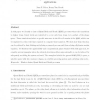Free Online Productivity Tools
i2Speak
i2Symbol
i2OCR
iTex2Img
iWeb2Print
iWeb2Shot
i2Type
iPdf2Split
iPdf2Merge
i2Bopomofo
i2Arabic
i2Style
i2Image
i2PDF
iLatex2Rtf
Sci2ools
191
click to vote
PE
2011
Springer
2011
Springer
Quasi-birth-and-death processes with restricted transitions and its applications
In this paper we identify a class of Quasi-Birth-and-Death (QBD) processes where the transitions to higher (resp. lower) levels are restricted to occur only from (resp. to) a subset of the phase space. These restrictions induce a specific structure in the R or G matrix of the QBD, which can be exploited to reduce the time required to compute these matrices. We show how this reduction can be achieved by first defining and solving a censored process, and then solving a Sylvester matrix equation. To illustrate the applicability and computational gains obtained with this approach, we consider several examples where the referred structures either arise naturally or can be induced by adequately modeling the system at hand. The examples include the general MAP/PH/1 queue, a priority queue with two customer classes, an overflow queueing system and a wireless relay node.
Related Content
| Added | 14 May 2011 |
| Updated | 14 May 2011 |
| Type | Journal |
| Year | 2011 |
| Where | PE |
| Authors | Juan F. Pérez, Benny Van Houdt |
Comments (0)

